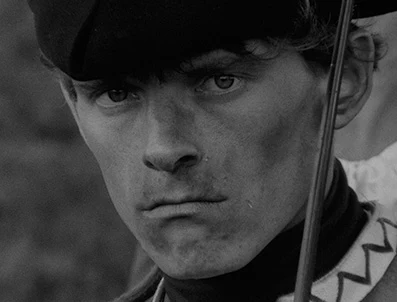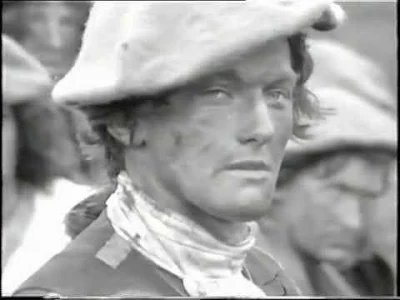When Cornwallis' chased off after Greene he took the best of the best with him. Lord Rawdon was left to defend South Carolina with a mixed bag of worn out understrength British regiments, poor moral Hessian regiments used for garrisson duty and a number of crack loyalist regiments. There was little cavalry and most were mounted infantry who were learning on the go. Quite the opposite of Cornwallis' army. Yet, he accomplished wonders with it and his army can make a very good table top collection. Please note that information on loyalist uniforms is sketchy at best and most documents are for 1783 so what a particular regiment wore and when is often a best guess. Most details for uniforms would be similar to dress in Cornwallis' army.
British Regiments:
3rd Regiment:
Arrived June 3, 1781. Took part in relief of Ninety Six and Battle of Eutaw Springs. Uniform red coat with buff facings, small clothes and belting. It is not known if they adapted their uniforms to campaign conditions or not. So possible to use figures in their 1768 regulation uniforms.
17th Company
Served with Provincial Light Infantry in operations against Marion and other partisans. Made up from survivors of the 17th Regiment of Foot after Stoney Point. Dressed in the battalion companies uniform of red coat faced white, cocked hats, and overalls. Officer silver lace.
Marjoribanks' Flank battalion
Made up of the light and Grenadier companies from the 3rd, 19th and 30th Regiments. It is not known if they adapted their uniforms to campaign conditions or not. So possible to use figures in their 1768 regulation uniforms.
19th Regiment
Arrived June 3, 1781. Took part in relief of Ninety Six. Regimental baggage lost at Monk's Corner S.C. July 1781 and fought at Quinby Bridge. Flank companies at Eutaw Springs. It is not known if they adapted their uniforms to campaign conditions or not. So possible to use figures in their 1768 regulation uniforms.
30th Regiment
Arrived June 3, 1781. Took part in relief of Ninety Six. Uniform red coat with pale yellow facings. It is not known if they adapted their uniforms to campaign conditions or not. So possible to use figures in their 1768 regulation uniforms.
63rd Regiment
Sent to siege of Charleston in 1779 and remained in South Carolina until 1782. Detachments fought as mounted infantry at Fishdam Ford and Blackstock's Hill in 1780. Regiment fought at Hobkirk Hill and Eutaw Springs 1781. Green facings. Officers gold lace.
64th Regiment
Fought at siege of Charleston 1779 and Eutaw Springs 1781. Very active against Marion and fought a series of actions against him. Uniform black facings. Officers gold lace.
82nd Regiment
Arrived in South Carolina as part of General Leslie's reinforcement December 1780. Black facings. Officers gold lace.
2/84th Regiment (Royal Highland Emigrants)
Sent to South Carolina April 1781 and fought at Eutaw Springs. Originaly dressed in Highland uniform similar to 42nd. May have worn overalls in south rather then kilt. Blue facings. Officers gold lace.
Loyalist Regiments:
Provincial Light Infantry
Arrived with the forces under General Alexander Leslie in December 1780.
Formed in New York in 1780, the battalion was made up six companies from the following loyalist regiments: 1st, 2nd and 3rd battalions New Jersey Volunteers (blue facings),3rd bn. De Lancey's (green facings),Loyal American Regiment (green facings) and King's American Regiment (Blue facings) and numbered about 200 men. They were commanded by Lieutenant Colonel John Watson Tadswell Watson, a Guards officer. The battalion wore their parent regiments uniform but were to be equipped as light infantry. They also had a company from the 17th Regiment of Foot operating with them. For most of their time in the south they operated in anti partisan operations against Sumner and later with the 64th Regiment of Foot and a troop of loyalist horse against Francis Marion's partisans. They took part in the Battle of Eutaw Springs.
Volunteers of Ireland (2nd American Regiment)
The regiment was raised in Philadelphia Pennsylvania during the British occupation in 1777 by Francis Rawdon-Hastings. He had been given permission to form a British Provincial regiment from Irishmen, serving in the American Thirteen Colonies. It was felt that many of these men would desert to the Crown of such a regiment was raised. Known as the Volunteers of Ireland the regiment was placed on the American establishment as the 2nd American Regiment (Volunteers of Ireland) on 2 May 1779.
The Volunteers served at the siege of Charleston in 1780, and the Battle of Camden 1780. Sergeant Thomas Hudson of the Volunteers received a decoration for heroism at Camden. The regiment fought at the Battle of Hobkirk's Hill in April 1781, as well as the relief of the Loyalist fort at the Siege of Ninety-Six in May 1781.
New York Volunteers (3rd American Regiment)
One of the very first loyalist fighting regiments they had a long and stories history. Organized as two independent companies under Captains Grant and Campbell in late 1775, they fought at the Battle of Long Island although "dressed in rags." They later took part in the fighting around White Plains New York. Sent south with Colonel Archibald Campbell in 1779 they fought in Georgia and South Carolina. After their defense of Rocky Mount their commander Colonel Turnball suggested they were given a standard. In addition a company from the regiment under Captain Coffin was equipped as cavalry and served as dragoons at Hobkirk's Hill and Eutaw Springs battles. In 1779 they were taken on the American Establishment as the 3rd American Regiment. Uniform is based on returns in 1782 which suggest they wore red coats faced blue. Prior to that it is very unclear and contradictory. Officers appear to have had silver lace .
Kings American Regiment (4th American Regiment)
The King's American Regiment was raised in New York in December 1776 by Colonel Edmund Fanning. It took part in the 1777 attacks on Fort Clinton and Fort Montgomery, the 1780 Siege of Charleston, the 1781 raids on Newport and Richmond, Virginia, and the 1781 Campaigns in South Carolina, Georgia and East Florida. The regiment was brought into the American Establishment, on March 7, 1781 and renamed the "4th American Regiment". The regiment became part of the British Establishment in 1782 (possibly as the "110th Regiment of Foot" ) and was disbanded in Canada in 1783. During much of their history they fought along side the New York Volunteers at Fort Montgomery and Fort Clinton 1777 and again later at Hobkirk Hill 1781. The regiments uniform for much of their history appears to be red coats faced green (later faced blue). Officers lace was gold.
South Carolina Royalists
Although raised as an infantry battalion by the summer of 1781 they were converted to a legion type organization. From a nine company infantry regiment eight companies were equipped as cavalry, and one infantry company. In this configuration they were more mobile and equipped to fight the American partisans. They reverted back to infantry companies before being moved to to St Augustine, November 1782 . It appears the regiment had many black soldiers in its ranks. When disbanded in October 1783 the white soldiers were sent to settle in Nova Scotia. Black soldiers were combined with other men from various loyalist corps and sent to the West Indies to serve there as Carolina Corps.

There is not a lot of documentation for this regiment so it's a educated guess based on what is out there. Here is what we do know; Early in their history they had red coats faced white. Wiederhold’s 1783 Almanack states that the South Carolina Royalists had red coats, but no facing and button colors are indicated. The 1783 New York List mentions “Red Coat — Yellow Lappel Variety button hole,” for the South Carolina Royalists. It is also possible they might have had blue jackets for a short time.
3/DeLancy
Red coat faced green in 1783.
2/New Jersey Volunteers
Red coat faced blue 1783.
Coffins Dragoons (Mounted company NYV)
Raised from a company of infantry from the New York Volunteers. A report from December reported the men dressed in "green jackets.". These were either left over uniforms from the NYV rifle Company or possibly from Queens Rangers or British Legion uniforms in supply at Charleston.
South Carolina Dragoons
Commanded by Captain Edward Fenwick this troop Of about 30-40 men served with the South Carolina Royalists. no documents about uniform.
South Carolina Rangers
Raised in Charleston in 1780 and served in that area. Commanded by Major John Harrison. Nothing known about uniform.
Hessian Regiments
By 1781 Hessian regiments were usually second class units and reserved for garrisson duty. They seldom took the field. Researching Hessian regiments can be confusing due to the name of the regiment changing with new commander.
De Angelelli
Originally the Grenadier Regiment Rall. Part of the garrison of Charleston about 400 men. Uniform blue coat lined red with red collar and cuffs. Small clothes buff. Brass Grenadier caps.
Fusiliers Regiment Ditfurth
Part of the garrisson of Charleston. As a Fusilier regiment wore brass cap with yellow bag edged white. Blue coat lined red and pale yellow facings. Small clothing yellow and red neck stocks. Officer lace gold. About 500 men.
Garrison Regiment von Huyn
Part if the garrison of Charleston. About 500 men. Uniform blue coat with yellow collar and cuffs and lined red. Small clothes buff. Officers lace silver.























































